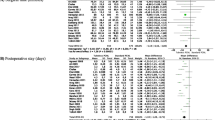Abstract
Percutaneous Nephrolithotomy (PNL) is an established technique for the treatment of renal calculi. Some reports have challenged the need for a nephrostomy tube at the end of the procedure, arguing that it accounts for a longer hospital stay and increased postoperative pain. During the last years, several series have addressed the feasibility and safety of tubeless PNL, where a double-J ureteral stent is left in place after the end of intervention instead of a nephrostomy tube. The aim of our study was to compare conventional versus tubeless PNL in terms of postoperative morbidity. Eighty-five patients who underwent PNL at a single center met the inclusion criteria (complete intraoperative stone clearance, no evidence of active intraoperative bleeding, single percutaneous access, and operative time shorter than 2 h) and were randomized at the end of the procedure to have placed either a nephrostomy tube (group 1) or a double-J ureteral stent (group 2). Outcomes assessed were postoperative pain, bleeding complications, leakage complications, and length of hospital stay. The patients in the tubeless group had a shorter hospital stay (3.7 vs. 5.8 days; P < 0.001), and less postoperative pain at postoperative days 2 and 3 (P < 0.001). No significant difference in bleeding or leakage complications was observed. This study supports the feasibility and safety of tubeless PNL in a selected group of the patients, suggesting some intraoperative criteria to be considered when performing it. However, further controlled studies will have to determine its impact on stone-free rates prior to be considered the standard technique in these selected cases.

Similar content being viewed by others
References
Uribarri J, Oh MS, Carroll HJ (1989) The first kidney stone. Ann Intern Med 111:1006–1009
Alken P, Hutschenreiter G, Gunther R (1982) Percutaneous kidney stone removal. Eur Urol 8(5):304–311
Clayman RV, Surya V, Miller RP et al (1984) Percutaneous nephrolithotomy: extraction of renal and ureteral calculi from 100 patients. J Urol 131(5):868–871
Segura JW, Patterson DE, LeRoy AJ et al (1985) Percutaneous removal of kidney stones: review of 1, 000 cases. J Urol 134(6):1077–1081
Goodwin WE, Casey WC, Woolf W (1955) Percutaneous trocar (needle) nephrostomy in hydronephrosis. J Am Med Assoc 157(11):891–894
Morris DS, Wei JT, Taub DA et al (2006) Temporal trends in the use of percutaneous nephrolithotomy. J Urol 175:1731–1736
Deane LA, Clayman RV (2007) Advances in percutaneous nephrostolithotomy. Urol Clin North Am 34:383–395
Ramakumar S, Segura JW (2000) Renal calculi: percutaneous management. Urol Clin North Am 27:617–622
Bellman GC, Davidoff R, Candela J et al (1997) Tubeless percutaneous renal surgery. J Urol 157(5):1578–1582
Sofer M, Beri A, Friedman A et al (2007) Extending the application of tubeless percutaneous nephrolithotomy. Urology 70(3):412–416 discussion 416–417
Crook TJ, Lockyer CR, Keoghane SR et al (2008) A randomized controlled trial of nephrostomy placement versus tubeless percutaneous nephrolithotomy. J Urol 180:612–614
Desai MR, Kukreja RA, Desai MM et al (2004) A prospective randomized comparison of type of nephrostomy drainage following percutaneous nephrostolithotomy: large bore versus small bore versus tubeless. J Urol 172(2):565–567
Agrawal MS, Agrawal M, Gupta A et al (2008) A randomized comparison of tubeless and standard percutaneous nephrolithotomy. J Endourol 22(3):439–442
Bodian CA, Freedman G, Hossain S et al (2001) The visual analog scale for pain: clinical significance in postoperative patients. Anesthesiology 95(6):1356–1361
Delnay KM, Wake RW (1998) Safety and efficacy of tubeless percutaneous nephrostolithotomy. World J Urol 16(6):375–377
Limb J, Bellman GC (2002) Tubeless percutaneous renal surgery: review of first 112 patients. Urology 59(4):527–531 discussion 531
Shah HN, Kausik VB, Hegde SS et al (2005) Tubeless percutaneous nephrolithotomy: a prospective feasibility study and review of previous reports. BJU Int 96(6):879–883
Rana AM, Mithani S (2007) Tubeless percutaneous nephrolithotomy: call of the day. J Endourol 21(2):169–172
Shah HN, Sodha HS, Khandkar AA et al (2008) A randomized trial evaluating type of nephrostomy drainage after percutaneous nephrolithotomy: small bore vs tubeless. J Endourol 22(7):1433–1439
Damiano R, Oliva A, Esposito T et al (2002) Early and late complications of double pigtail ureteral stent. Urol Int 69:136–140
Vega Vega A, García Alonso D, García Alonso CJ (2007) Characterization of urinary tract symptoms and quality of life in patients with double-pig-tailed ureteral stents. Actas Urol Esp 31(7):738–742
Pryor JL, Langley MJ, Jenkins AD (1991) Comparison of symptom characteristics of indwelling ureteral catheters. J Urol 145(4):719–722
Vallejo Herrador J, Burgos Revilla FJ, Alvarez Alba J et al (1998) Double J ureteral catheter. Clinical complications. Arch Esp Urol 51(4):361–373
Joshi HB, Stainthorpe A, Keeley FX Jr et al (2001) Indwelling ureteral stents: evaluation of quality of life to aid outcome analysis. J Endourol 15:151–154
Leibovici D, Cooper A, Lindner A et al (2005) Ureteral stents: morbidity and impact on quality of life. Isr Med Assoc J 7(8):491–494
Matin SF, Feeley T, Kennamer D (2009) Office cystoscopy and transrectal ultrasound-guided prostate biopsies pose minimal risk: prospective evaluation of 921 procedures. Urology 73(6):1175–1178
Raman JD, Bagrodia A, Bensalah K et al (2010) Residual fragments after percutaneous nephrolithotomy: cost comparison of immediate second look flexible nephroscopy versus expectant management. J Urol 183(1):188–189
Author information
Authors and Affiliations
Corresponding author
Rights and permissions
About this article
Cite this article
Marchant, F., Recabal, P., Fernández, M.I. et al. Postoperative morbidity of tubeless versus conventional percutaneous nephrolithotomy: a prospective comparative study. Urol Res 39, 477–481 (2011). https://doi.org/10.1007/s00240-011-0367-9
Received:
Accepted:
Published:
Issue Date:
DOI: https://doi.org/10.1007/s00240-011-0367-9



